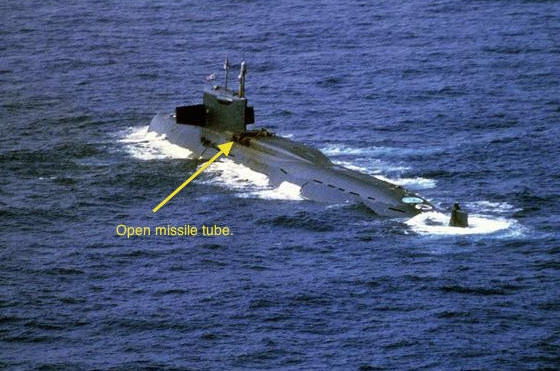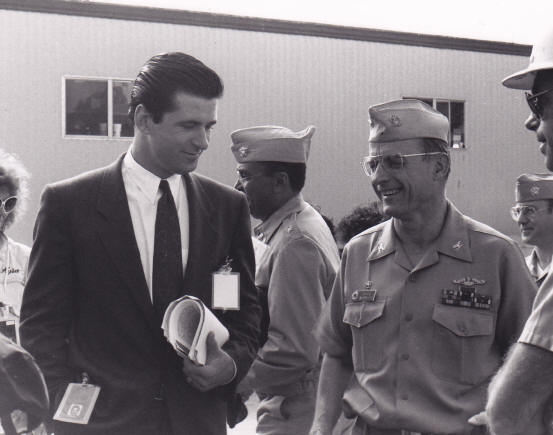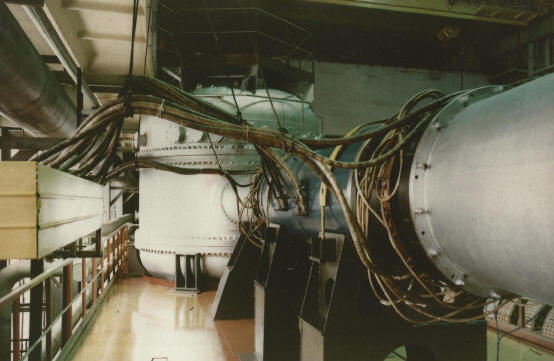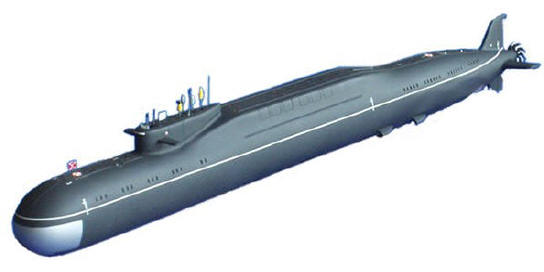|
Cold War Warriors
The Scrapping of the Red October
Captain Edmond D. Pope, USN Ret.

Typhoon-class SSBN, designated the Akula class by it’s Soviet builders
The Russian Navy recently announced that it would decommission and scrap its last two Typhoon-class ballistic missile submarines by the end of this year. This action will mark the close of a chapter of the Cold War that has seen this submarine featured in books and movies more prominently perhaps than any other submarine in modern history.
The Typhoon is remarkable for a number of reasons, not the least of which is its enormous size; at 48,000 tons, the Typhoon is the largest production submarine ever built; well over twice the tonnage of the U.S. Ohip-class Fleet Ballistic Missile submarines and even matches the size of most WWII aircraft carriers. Actually, the Typhoon is a multitude
of heavy pressure hulls contained inside the outer "light" hull: inside the external submarine hull are two large pressure hulls housing propulsion machinery, a smaller command module pressure hull which includes the sail section, and other modules that hold the ballistic missiles, torpedoes and steering machinery. The size and complexity of the Soviet, now Russian, submarine
however is what led the Russian Navy to retire the boats; they simply could not afford to maintain them. By its own accounting, the Russian Navy has found that they could build two new Borley-class ballistic missile submarines which are just coming into service at the same cost of overhauling a single Typhoon boat.
A total of six Typhoon submarines were constructed during the 1980’s and all operated out of bases in the Barents Sea (a seventh made it onto the building ways before they ran out of money and it was scraped in 1990 before it ever went into the water.) The Typhoon submarines were built to carry 20 submarine-launched ballistic missiles, each capable of
carrying 10 independently targetable, nuclear warheads. Each of the Typhoon submarines was thus estimated to be capable of carrying more raw firepower, i.e. megatons, than all of the munitions expended during WWII by all combatants. The new missile developed for this class was believed to be capable of launching at targets while moored at their docks.
The class name given to this submarine by the Soviets is Akula ("Shark" in Russian) while the NATO designator Typhoon is more commonly recognized for this class. The source of the NATO class name remains uncertain, however, it is likely a result of the use of the word "Typhoon" by Premier Leonid Brezhnev in a 1974 speech while describing a new type of
nuclear ballistic missile submarine that was then under development.
The Typhoon submarines rarely ventured out into the Atlantic but typically remained in the Barents, Kara, or Arctic seas and were occasionally noted to operate under the Arctic ice cap. This tactic would allow them to surface through the ice during wartime to launch their missiles thus significantly complicating Western efforts to locate and destroy
them.
As a result of the information provided to the Soviets by former U.S. Navy Chief Warrant Officer John Walker and his circle of collaborators, the Soviets modified their strategy to what is referred to as the "bastion" operating concept. In addition to other critical information provided the Soviets by Walker’s treasonous activity, they discovered how
readily the U.S. Navy was capable of tracking and trailing their submarines while remaining undetected themselves. Typically, a bastion area would be partially enclosed by a friendly shoreline, heavily defended by naval mines and monitored by sensors, and subject to rapidly deployed, friendly forces.
The resultant transition to this bastion strategy for their newest ballistic missile submarines also saw a missile upgrade for the older Soviet submarines. Specifically, the Yankee and Delta-class submarines, which were equipped with a more modern and higher accuracy missile system that allowed them to continue their operations in the open Atlantic,
but with far more tactical maneuvers such as the "Crazy Ivan" and other moves looking for any trailing Western submarines.
One unfortunate submarine of the Yankee class, K-219, suffered a catastrophic explosion and fire in an operating area some 700 nautical miles northeast of Bermuda in October 1986. After a leak was detected in one of its missile silos, a fire and explosion resulted from the residue of the liquid-fueled missile. The crew was unable to contain the leak
after ejecting the missile into the open ocean. Confusion then ensued when most of the crew boarded a nearby Soviet merchant ship and took the crippled submarine undertow. Naval headquarters in Moscow ordered the crew to reboard the submarine but it sank in 18,000 feet of water with 6 crew aboard before this could be accomplished. One report that later surfaced in Russia,
suggested that the accident was a result of a collision with a U.S. attack submarine. Indeed, the USS Augusta (SSN-710) was ordered to conduct surveillance of the incident but had not been trailing the YANKEE submarine as some reports have suggested. Making such claims appears to be "standard operating procedure" by some in the Russian Navy but certainly was not the case with
K-219.

K-219 traveling on the surface after ejecting one of its missiles.
It soon sank in over 3 miles of water in the Atlantic with 6 crew members aboard.
While the movie version of Tom Clancy’s novel "The Hunt for Red October" used the hull form of the Typhoon class submarine, the scenes of the conning tower used in the movie were actually crafted of plywood and placed on a barge for close up shots depicting the Red October departing port.
It is not uncommon for U.S. Department of Defense components to support Hollywood film production and the making of the film "The Hunt for Red October," was one such effort that produced a much more authentic movie than would otherwise have been possible. Submarine Squadron Eleven (COMSUBRON 11) commanded by
Commodore Bill Hicks in San Diego, served as the host for support to the Red October film producers. Inside the submarine community, this film was viewed as a response to Naval Aviation’s assistance and subsequent notoriety in production of the hit movie "Top Gun".
Early in the preparations for the filming of Red October, a select group of the movie’s cast and production crew were treated to a day at sea aboard USS Salt Lake City (SSN-716) to see how a real 688 Los Angeles-class submarine operated. Also, COMSUBRON 11’s dry dock was used for those scenes of the sail and hull used in the movie. However, a small
problem arose, as the submarine in the dry dock that day was considerably smaller than a Los Angeles-class submarine. As a result, the mockup of the small, mating-vessel that was shown in the dock being fitted on the sub (The USS Dallas in the movie) was proportionally reduced in size so the dimensions would be more accurate. USS Houston (SSN-713) was used to play the role of
the fictional USS Dallas in the movie during the exciting emergency surface footage.
The Red October surface shots were taken in Puget Sound, using the mockup of the Typhoon for the sail and topside shots of the crew. The scenes inside Red October and USS Dallas were filmed on sets in Hollywood. In a couple of cases, bit parts in the movie were played by COMSUBRON 11 junior officers. Apparently it was easier to train a naval officer to
act than to turn an actor into a naval officer.

Captain Bill Hicks with cast members of the Hunt for Red October on the pier next to the
COMSUBRON 11's dry dock - taken the day they filmed the dry dock scenes.
Without a doubt - for me, a far more interesting topic is the issue of the silent propulsion system the fictitious Red October submarine was equipped with. It was referred to as "tractor drive," "caterpillar drive," or, more accurately, Magneto Hydrodynamic Drive (MHD) in the movie. I learned during my visits to Russia that this system is not just a
figment of author Tom Clancy’s creativity or Hollywood’s imaginative writers. At one point in my travels, I was given a tour and photos of the Russian system and several Russian institutes discussed its merits with me, including the Krylov Shipbuilding Research Institute in St Petersburg, the Kaluga Turbine Works south of Moscow, and the Rubin Design Bureau in St. Petersburg
and it’s then, well-known chief design engineer Sergei Kovalev (he passed away in 2011).
Most of my Russian contacts viewed the system as yet another blind adventure of Moscow’s fascination with high-risk technologies of the Cold War era but they did like the way Hollywood had incorporated the system into their movie. I was still on active duty and working at the Office of Naval Research at this point and would routinely return with
dozens, if not more, proposals from my Russian contacts. Returning from that particular visit with photos and a proposal for cooperation in hand, we were indeed curious. After talking to specialists in our organization, we discovered things that most people in the West had forgotten that we had actually worked and shared in this effort with the Russians in the early 1970’s
under the Nixon-Brezhnev Cooperative Science and Technology program.

This photo depicts the electromagnetic coil and circulation tubing inside the Russian laboratory, on the outskirts of Moscow, where development of MHD was being studied. The coil structure in the middle of this photo is approximately 12 feet tall and inside the coil has stamped on it: Made in the U.S.A. by General Electric Corporation.
The image above is one of several given to me in 1993 which was later shared with a U.S. researcher who had been part of the original U.S.- Soviet working group that designed and set up the facility outside Moscow. Without going into detail, what we learned was that MHD would not serve as a viable propulsion system for submarines as the electrolysis
process left a highly visible trail of minerals and air bubbles in the water that could be easily tracked.
I visited the Kaluga Turbine "Zavod" (plant/works), which lies about 4 hours drive south of Moscow, on several occasions and found it a fascinating mix of the old and new. This is where the design and manufacture of turbine-drive equipment is conducted for the Russian Navy’s nuclear powered ships - both surface and submarine. In addition to the large
turbine factory, Kaluga is considered home to most of the modern Soviet/Russian astronautics programs. Konstantin Tsiolkovsky is widely credited with many of the very early concepts that later lead to modern aviation and space exploration. His early studies beginning in the 1890’s, focused on jet propulsion and helped establish many of the concepts used in today’s turbine
drive machinery. Much of his early work was so advanced that it was considered more fantasy than reality at the time. The irony of all this revered history, modern day manufacture of critical components for the Russian nuclear submarine force and Hollywood drama struck me the first time I entered the main office complex. In the entry foyer, an aspiring Russian entrepreneur
had set up a kiosk with a large banner labeled "American Video". My escort walked me over and made a point of showing me the most popular rental in the kiosk: Tom Clancy’s "The Hunt for Red October".

"Typhoon" class SSBN in the background and its replacement - "Borei" (Northwind)
SSBN in the foreground.
In addition to MHD, I was to discover many types of technology and advanced research that we had shared with the Soviets/Russians and many others that had been stolen. The first truly modern Soviet ballistic missile carrying submarine capable of submerged launch, the Yankee SSBN, was so much like our own USS George Washington-class FBM, that the Soviet
boat was frequently referred to as "Little George." In addition to our own traitors such as John Anthony Walker, the Soviet KGB and GRU as well as their client, Warsaw Pact partners had been busy stealing high priority American and Western technologies. The full extent of this espionage was first publicly introduced by the "Farewell" dossier in the early 1980’s when Soviet
KGB Colonel Vetrov was apprehended and executed in Moscow. Vetrov had provided French intelligence with thousands of documents outlining the extensive program used by Soviet officials to steal western technology. Russian agencies remain actively engaged in this espionage and their latest submarines will most likely carry numerous such advanced technologies. The external view
of the BOREY class shows striking similarities to our own Ohio-class FBM.

A scale model of the Russian Borey-class SSBN Yuriy Dulgoruki.
During one of my visits to St Petersburg, Russia, I purchased one of these models. The actual launch of this submarine only came about 6 years later due to economic difficulties. During my 2000 trial in Moscow, the state prosecutors charged that buying this model from a hobby shop was further "proof" of my espionage!!
The latest addition to the Russian arsenal, the BOREY-class SSBN is now entering operational status and additional units are being funded and built. Named after the Greek God of the cold North Wind, this platform and its new BULAVA (Mace) missile may indeed be a harbinger of winter, or return to Cold War strategy, by Mr. Putin as it replaces the
TYPHOON and DELTA class submarines as the Navy’s mainstay strategic platform. Currently, only the first unit of this class is operational but a second should become operational in several months and a third will soon begin its sea trials and will enter service sometime in 2014. The first three submarines are fitted with 16 advanced BULAVA submarine-launched ballistic
missiles. The next two Borey class submarines are scheduled to be an upgrade that will carry 20 ballistic missiles each.
Putting wind in the sails of this new and advanced platform, on the first of June it was revealed by officials in Moscow that the lead unit of this class of submarine, the Yuriy Dolgoruky, would soon begin patrols out into the open ocean and as far south as the "South Pole." This will represent the return to operations that have not been conducted in
over twenty years.
Edmond D. Pope is a retired Navy Captain and former Naval Intelligence Officer. Following retirement from the Navy he was employed by Penn State’s Applied Research Laboratory. He was accused and convicted of espionage by the Russian government in 2000. More about his adventures in Russia can be found in his book "Torpedoed" and at his Web site
http://edmondpope.com/. Edmond Pope currently lives in State College, PA.
Read other articles by Captain Edmond D. Pope
Read other Cold War Warrior
Articles
|